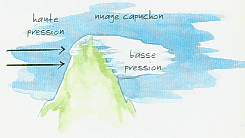Bernard and Dorjee may see some spectacular stratus clouds created by the particular orography of a high mountain like Everest. What are they, and how are they formed?
Nature truly offers an extraordinary spectacle for those who make it to the roof of the world.
When the wind blows on a mountainside, an air bubble builds up, creating high pressure conditions on one side of the mountain. A low-pressure zone builds up on the other (lee) side in response.
As everyone knows (right?), a low-pressure zone combined with sufficient moisture creates condensation and forms clouds. These stratus clouds, known as “cap clouds,” look as though they are attached to the peak of Everest.
Who knows, perhaps Bernard will be able to compare them with the cap clouds he sees over Mont Cervin in the Alps, or somewhere else in the world, on some future expedition…
“Was it cold at the summit of Mount Everest at 8 850 metres in altitude?”
This question has been asked hundreds of times to Bernard since he has reached the summit of the highest mountain on earth, on May 5th 1999. He answered us ” The temperature at the summit was approximately -25°C. This doesn’t seem very cold, but with the rarefaction of oxygen, it feels much colder. We never get to warm up. Our movements are very slow… and there is not enough place to jump…!!! At this altitude we inhale a large volume of air, and this air is very cold.”
“At the South col, at 8 000 metres in altitude at camp IV, it was colder than at the summit, approximately -35°C. Coming back from the summit, we have to spend the night at this camp. Tired out, exhausted, the cold is biting. Fortunately the satisfaction of having reached the summit warms my heart and soul.”